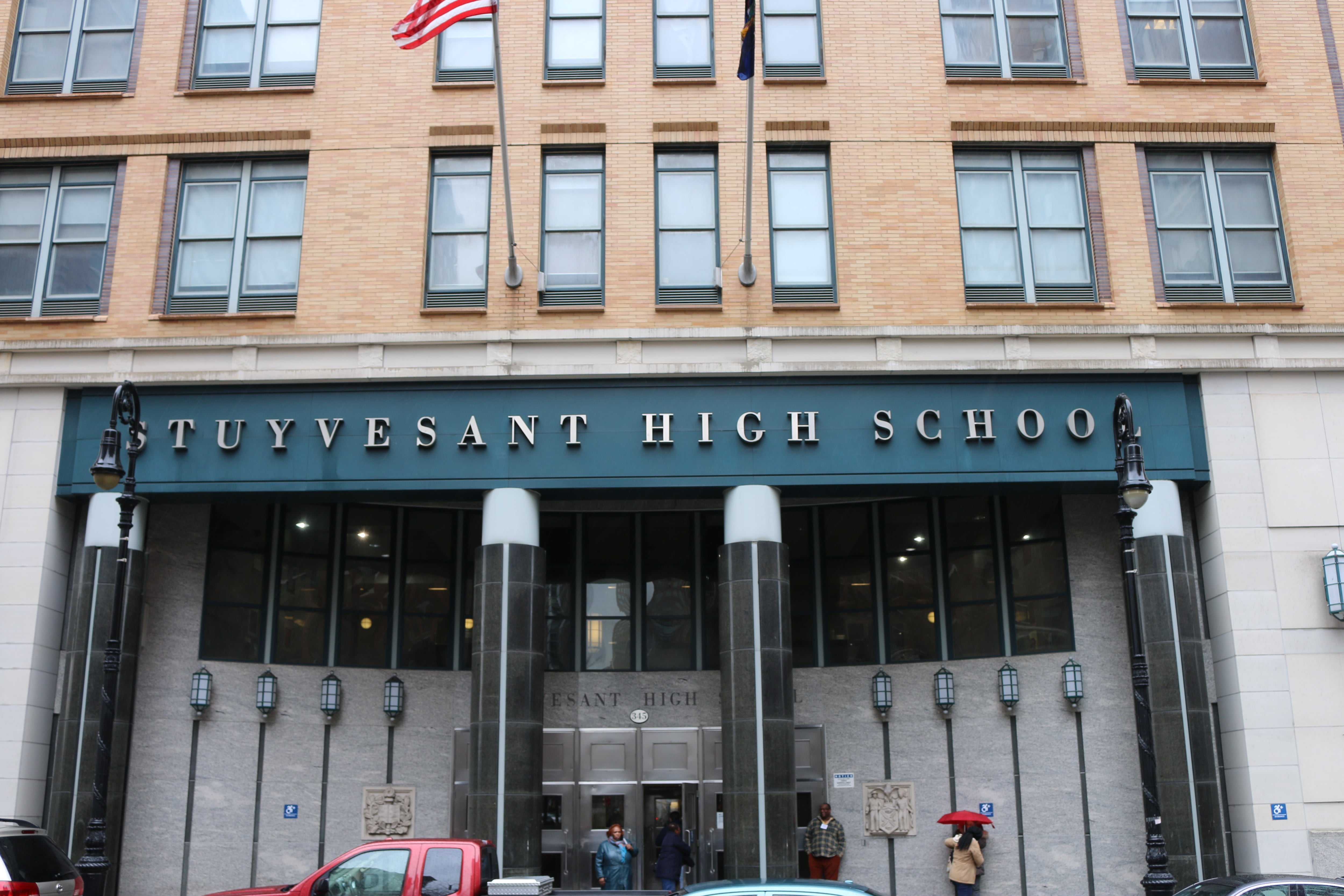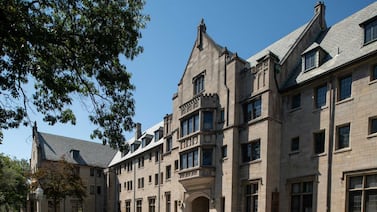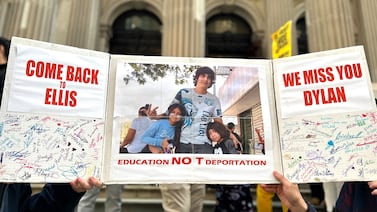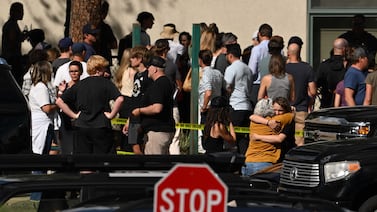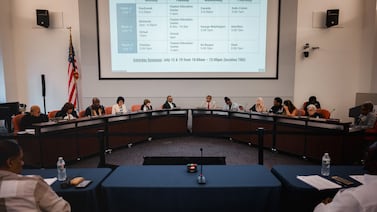A task force charged with rethinking the way New York City distributes school funding released recommendations on Friday that could help shift how hundreds of millions of dollars are distributed to more than 1,500 public schools.
Many of the proposals would have implications for a broad swath of schools if adopted, including boosting funding at campuses that enroll more homeless students and those living in poverty.
Other recommendations would impact a relatively small set of schools but are nonetheless likely to draw controversy, including a proposal to eliminate a special funding boost at 13 of the city’s most selective high schools.
None of the ideas are binding — it’s now up to schools Chancellor David Banks and Mayor Eric Adams to decide whether to tweak the city’s funding formula for next school year. The report’s public release may create political pressure to act, as a previous task force convened under the last administration fizzled out before formally releasing any recommendations.
But enacting the task force’s proposals would either require a big influx of new funding or significant cuts to some campuses, both of which would likely face political hurdles.
The task force’s report focuses on the city’s “Fair Student Funding” formula, which funnels about two-thirds of the money that flows to school budgets. Schools typically receive a baseline amount per student — this year, it’s about $4,197. Students with additional needs — including those with disabilities, English language learners, and students with low test scores — come with additional dollars on top of the baseline.
The city’s funding formula is among the most progressive in the country, but advocates have long pushed for tweaks. The latest task force was created after the city’s Panel for Educational Policy, which is largely appointed by the mayor, took the unusual step of voting against the funding formula for this school year. Though the formula was later approved, officials promised to launch a working group to solicit feedback.
The report’s proposals taken together would cost between $375 million and $983 million, depending on which specific combination of recommendations are included, according to education department figures.
Without additional funding, steering more money to certain campuses will require cuts to others. Large schools and those with fewer low-income students would face significant cuts under that framework, city projections show. That could be a political non-starter, since the vast majority of schools are already facing cuts thanks to shrinking enrollment.
Alternatively, the city could allocate new money to the city’s schools to pay for the changes to ensure they don’t reduce school budgets. But top officials have already signaled that they plan to make across-the-board cuts to city agencies, including the education department.
In a letter to working group members, Banks wrote that the education department would evaluate the proposals “within the current fiscal context” and use the recommendations to apply the formula “most equitably for next year.”
The city’s teachers union — which participated on the task force alongside parent leaders, policy experts, and advocates — raised concerns about how the proposals would be funded in the days leading up to the report’s release, according to a copy of a letter to other task force members obtained by Chalkbeat.
“Given the losses our schools and students have suffered in recent years, the last thing the system should be doing is setting up a ‘Hunger Games’ scenario that will pit school against school,” wrote Michael Mulgrew, the union’s president. “The plan must include a hold-harmless provision that will protect schools from seeing their budgets decline if these recommendations are enacted.”
Jasmine Gripper, executive director of the advocacy group Alliance for Quality Education and a co-chair of the task force, said questions about how to pay for proposals was a source of tension within the group.
“What we’re trying to do is drive more resources to schools with the greatest needs and we don’t want to rob Peter to pay Paul,” she said. At the same time, “There are people who think the system doesn’t need more money — it just needs to be distributed better.”
Gripper added that the task force only had three months to come up with proposals, limiting the group’s ability to do a complete review, though she said the current recommendations are a good start.
The report notes that there was not “whole group consensus” on the recommendations and two of the task force’s members released their own set of proposals separate from the larger group. The report also proposes that the task force continue meeting.
For now, though, here’s what the task force’s current recommendations would do:
Funnel more money to homeless students and those living in poverty
Nearly 10% of the city’s students live in temporary housing, including a recent influx of migrants from South American countries. While some federal funding is allocated for homeless students, the city’s formula does not attach extra money to those children. The working group wants the city to change that.
The education department should increase the base amount of per-student funding 12% to 24% per homeless student, the report recommends, which would cost between $43 million and $86 million. Without new funding for that change, the city projects the new weight for homeless students would shift funding from about 700 lower-poverty schools to higher-poverty ones.
The report argues additional funding is needed to address chronic absenteeism, higher dropout rates, and intense stressors related to housing instability. Principals can spend money allocated through the funding formula as they see fit, but the report suggests that school leaders use it to hire extra social workers or partner with community organizations — groups that often provide social services, attendance outreach, and more.
Children living in poverty — or roughly 70% of the student population — should also come with extra funding, the report says. The city already allocates some additional funding for low-income students, but it is limited to schools that serve students below the fourth grade. Expanding the poverty weight even modestly is expensive — between $138 million to $276 million, depending on how aggressively it is increased — because such a large percentage of students come from low-income families.
Nix the special bonus for elite high schools
The city’s funding formula is designed to send extra resources to schools that enroll high-need students. But a group of 13 elite high schools — serving relatively few Black and Latino students, English learners, or students with disabilities — receive a special bonus payment. This year, it’s about $1,049 per student.
The report recommends eliminating extra funding to those 13 schools, which include eight specialized high schools that admit students based on a single exam. Instead, the city should distribute that money, about $26 million, “to support advanced coursework for a broader reach of students,” according to the working group.
Funding for the city’s schools should primarily drive more resources to needy students and “a weight for specialized academic high schools does not necessarily align with this overarching vision for increased equity,” the recommendation states.
The report does not spell out precisely how to redistribute the money. The proposal is likely to prove controversial, as the move would reduce funding at some of the city’s best known and most politically connected schools, including Stuyvesant (which would lose $4.3 million), Brooklyn Tech ($8 million), and Bronx Science ($4 million).
New funding for high-need schools
With a few exceptions, the city’s funding formula allocates money based on student headcount rather than to specific schools. But the working group recommends that the city add a new funding stream specifically for schools that serve unusually high concentrations of homeless students, those with disabilities, English learners, students in foster care, and those from low-income households.
“Schools serving students with a greater myriad of needs require more resources to support these populations than weights at the individual student level provide,” according to the report.
The top third of schools with larger concentrations of high-need students would receive additional funding while the majority of schools would give up some. Depending on the exact model for implementing the proposal, even high-poverty schools could lose some money because they don’t serve high concentrations of other high-need student groups. The education department projects the change would cost $60 million to $120 million.
Boost base funding for all campuses — but concerns about small schools loom large
On top of per-student funding, each school receives $225,000, traditionally to pay for a principal and a secretary. The report recommends boosting that amount to cover additional positions, as some campuses may struggle to pay for a full range of mental health and academic staff — particularly those with fewer students.
The working group recommends two different possible funding boosts. One would add $105,000, or roughly the cost of a social worker. Another would raise the base allocation by $345,000, which would include the cost of a social worker, guidance counselor, and assistant principal.
These proposals are pricey: between $160 million and $526 million. Without additional funding, the proposal would represent a significant transfer of resources from larger schools to small ones and would only modestly increase funding for higher-poverty schools, according to the education department’s analysis. The city’s 10 largest schools would lose an average of $712 per student.
Increasing school funding regardless of student enrollment helps smaller schools, which have grown in number as enrollment has fallen dramatically. But it also raises questions about whether shrinking campuses should wind up with significantly more funding per student even as their ability to offer a full range of programs declines.
“Increased investment in schools with less than 200 students may only prolong an inevitable decline in funding to levels that cannot sustain increasingly small schools,” the report notes. “Given that these schools largely serve high need students, it is incumbent on NYC Public Schools to find longer term solutions to the growing numbers of small schools.”
This story has been updated with additional context about the task force’s deliberations.
Alex Zimmerman is a reporter for Chalkbeat New York, covering NYC public schools. Contact Alex at azimmerman@chalkbeat.org.

